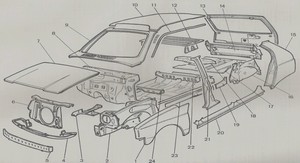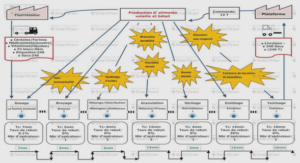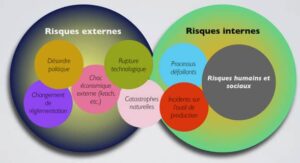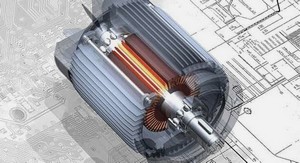Rotorcraft aeromechanical system bond graph
Rotor-airframe model using multibody dynamics
A central coupling to be modeled in rotorcraft dynamics is the rotor-airframe one. This coupling is at the heart of the most classic aeroelastic phenomenon in helicopters such as ground resonance, air resonance (Krysinski & Malburet, 2011). Many historical analytical models of this coupling can be found in literature in (Takahashi & Friedmann, 1991) and with a minimalistic number of degrees of freedom in (Krysinski & Malburet, 2011). To avoid these phenomena (Donham, 1969), (Krysinski & Malburet, 2011) a damper is introduced in articulated rotor systems around the lag axis between blades and hub to damp the amplitude of blade lag, see Figure 2-3, movement and position the frequency of its oscillations. The design of this lag damper is a major concern for rotorcraft designers and it is chosen here to model it with linear characteristics. Since lateral-roll RPCs are known to appear at relatively low frequencies, between 2 and 8Hz (Pavel, et al., 2013), (Muscarello, et al., 2015) the blades and fuselages can be considered as rigid bodies. Modeling them as rigid bodies is an acceptable approximation (Bielawa, 2006) to capture the relevant dynamics at low frequencies, around 3Hz. The fuselage is given 3 degrees of freedom centered on its center of gravity: roll, lateral translation and vertical translation, see Figure 5. Choosing these degrees of freedom allows the center of gravity to have a planar movement, normal to y3 see Figure 2-2. Each blade of the rotor is allowed to flap, lag and pitch see Figure 2-3. In (Pavel, et al., 2013) the flap-lag and blade torsion coupling is mentioned to be modeled when investigating high load maneuvers. It is important to mention too, that during the same high load factor maneuvers, hingeless soft-in plane rotors lag dampers lose their damping and stiffness characteristics decreasing the damping of the flap-lag coupling. In this approach the coupling with blade torsion is however neglected.In this section, classic assumptions have been adopted for the mechanical part. In the next, the development of the bond graph to this modeling assumption is presented as well as the aerodynamic model.
Multibody dynamics and Newton-Euler equations in bond graphs
There are many alternatives to derive the equations of motion of systems based on Newton’s laws, Hamilton’s principle, from which Lagrange equations can be derived or d’Alembert’s principle. While in Newton’s laws quantities are expressed in terms of vectors (force, momentum, angular momentum) in Lagrangians dynamics the vector quantities are substituted by scalar quantities (energy and work). A major difference between the two formulations results in the choice of coordinates one can make. In the case of Lagrangian dynamics, generalized coordinates of the system are defined globally for the system and eliminate the interaction forces resulting from constraints between elementary parts of the system (Preumont, 2013). When applying Newton laws one has more freedom in the choice of coordinates: each elementary part of the system coordinates’ can be chosen as dependent or independent from other elementary parts coordinates’. Since our interest is on engineering systems, a natural way of describing them is by using multibody dynamics in which the physical system is replaced “by rigid and or/flexible bodies, joints, gravity, springs, dampers and position and/or force actuators” (Eberhard & Schiehlen, 2006). The constrained system is then disassembled as free body systems using an appropriate number of inertial, moving reference and body fixed frames for the mathematical description (Eberhard & Schiehlen, 2006). When it comes to the bond graph method a procedure is proposed in (Karnopp D. , 1977), (Favre, 1997) to obtain the bond graph of a multibody system using generalized coordinates. The main drawback of this procedure (Favre, 1997) is that it demands a priori derivation of equations by hand before obtaining the bond graph. Another approach, more systematic (Tiernego & Bos, 1985), (Favre, 1997) in the sense there is no need to identify generalized coordinates or derive a priori any equations by hand is first proposed by (Tiernego & Bos, 1985). It is based on the fact that, when representing a multibody system of rigid bodies using Newton-Euler equations using bond graphs, a pattern appears. It can therefore be reproduced, copied, connected without the need to derive any equation by hand. In this representation the coordinates are relative coordinates10 . The application of this procedure has been used to investigate a flexible robot dynamics (Maschke, 1990), human gait modeling (Hernani, Romero, & Jazmati, 2011), and more recently in our laboratory on helicopter applications: a rotor-airframe system (Chikhaoui, 2013) and a helicopter suspension system (Boudon, 2014). When modeled with such procedure, the equations of motion can be obtained relatively easily. However, as often in mechanics, the easier the equations of motion are obtained, the more complex the mathematical models are: not only Ordinary Differential Equations (ODE) appear but also Differential Algebraic Equations (DAEs). This is due to the redundancy of coordinates and the implementation of constraints. Under the form of DAEs, a set of linear equations cannot be set in a systematic manner into state-space form, drastically limiting the possibilities to analyze the model or use it in a closed loop for real time calculation. And when the equations are nonlinear, which is the case when dealing with large displacements and complex engineering systems, special strategies have to be used to either transform the DAEs into ODEs or to directly integrate the DAEs with an adapted numerical method such as Backward Differences or Implicit Runge-Kutta, (Cuadrado, Cardenal, & Bayo, 1997), (Pennestri & Vita, 2004), (Mantegazza & Masarati, 2012). Without being exhaustive about how to model any system using bond graphs for which one can find excellent explanations in (Karnopp, Margolis, & Rosenberg, 2012), (Borutzky, 2009), the modeling of a multibody system in a systematic way is presented following the approach of (Tiernego & Bos, 1985). Using a systematic approach has of course the advantage of being applicable to a large class of problems but the drawback of probably not being the most computationally efficient for a particular problem.
Joint between blade and hub for lag-flap-pitch motions
The proposed representation could be classified with the classic methods of reduction of equations of motion such as transformation of inertial bond graph elements (Van Dijk & Breedveld, 1991), (Borutzky, 2009). This representation has been presented at the iNacomm 2013 conference at the Indian Institute of Technology, Roorkee, see (Tod, Malburet, Gomand, & Barre, 2013). By attaching the reference frame 4 to the hub, see Figure 2-8 and Figure 2-3, each blade angular velocity is defined as follows,On Figure 2-9, the concatenation of three revolute joints that represent equation (17) are presented with a ‘classic’ structure (a) and the proposed structure without the inclusion of any null sources of flow to relax causality (Tod, Malburet, Gomand, & Barre, 2013). The use of the proposed structure demands to introduce a modulated multiport transformer element (circled in blue on Figure 2-9) which contains a matrix that has to be derived by projecting all the vectors of the equation (17) in the reference frame 4 (hub). It leads to the matrix below, which is a rotation matrix from a non-orthogonal frame to an orthogonal one.
Quasi-steady aerodynamic forces
The previous sections have justified the modeling of the rotor-airframe system. In this section, the modeling of quasi-steady aerodynamic forces applied to each rotor blade is proposed. Aerodynamic forces play a fundamental role; however their modeling is an ongoing research challenge by itself. More sophisticated approaches include unsteady aerodynamics, stall and free wake geometry models. The aerodynamic forces can be considered in a first approach in the investigation of low frequency phenomena by considering the lifting-line theory with quasi-steady aerodynamics (Bielawa, 2006). In (Dryfoos, Kothmann, & Mayo, 1999) inflow velocity is neglected since the inflow dynamics are expected to be generally faster than the dynamics of interest. In the same paper it is argued that it can be reasonably well approximated by replacing the Lock number with the reduced Lock number: usually between 60 to 70% of the actual Lock number. Since the bodies represented before are considered as rigid for the dynamics of our interest, there is no need to any spatial discretization in the modeling. However, if flexible bodies where to be modeled, a spatial discretization would have been necessary for which bond graph representations exist (Borutzky, 2009). When modeling a blade, it can be necessary also to take into account for the variable characteristics (such as lift coefficient) of blade sections along their spans. In this case, a discretization of the velocity field along the blade span is necessary. The proposed modeling serves this potential need and has also the advantage leaving the possibility to represent not only hover flight but also forward flight configurations without any aerodynamic model modification.




